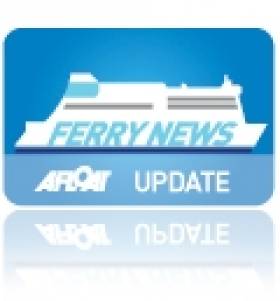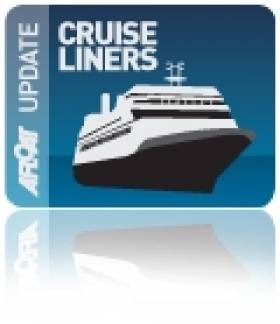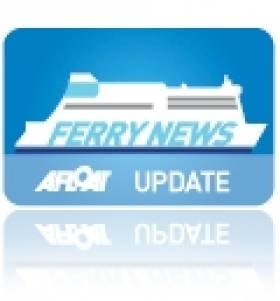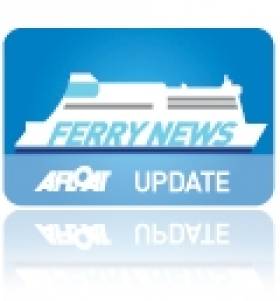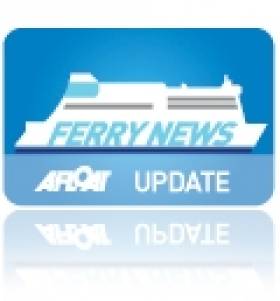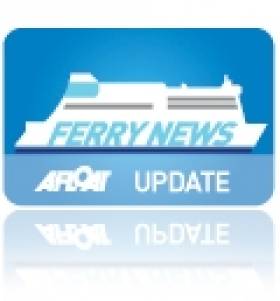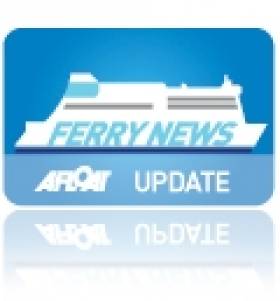Displaying items by tag: Ferry news
#FERRY NEWS - The veteran Stena Line ferry Stena Caledonia was spotted on sea trials in Belfast Lough last weekend pending its possible sale.
As Irish Sea Shipping reports, ASDP Ferry of Indonesia is thought to have an interest in acquiring the passenger vessel.
Stena Caledonia was withdrawn late last year to make way for Stena's second 'Superfast' ferry on the Belfast-Cairnryan route, as previously reported on Afloat.ie.
Pete Hodson captured a number of photographs as she made her way around the lough on Sunday 27 May, which can be seen HERE.
Former 'Lipstick' Ferry Calls to Saltees Islands
#SALTEES CRUISE CALL – The Saltee Islands off Co. Wexford was where the small cruiseship Expedition (1972/ 6,334grt) made an anchorage call yesterday, writes Jehan Ashmore.
The 140 passenger vessel which underwent a $13 million refit in 2009, specialises in cruising to some of the world's most remote regions. As usual for this type of cruiseship, a fleet of Zodiacs are provided for expedition excursions. Large common areas and observation decks provide panoramic views. As for all her cabins they too feature ocean-view windows or portholes and private en-suite facilities.
Expedition was a former Baltic Sea ferry which was sold in 2008 to G.A.P. Shipping Co. Ltd for their G-Adventures cruises having served as Ålandsfärjan for Viking Line's Mariehamn- Kapellskar on the Åland Islands route. The archipelago situated at the mouth of the Gulf of Bothnia form an autonomous Swedish-speaking region of Finland.
Prior to her Baltic Sea career she served P&O's subsidiary Normandy Ferries on the Dover-Boulogne route as their N.F Tiger which followed her original back-round as the Kattegat built for a Danish operator four decades ago.
The cruiseship retains her distinctive bright red hull colour inherited from her Viking Line years. Intriguingly when the company had to choose what colour to use for their first ferry Apollo, the answer found was rather novel as one of the owner's relatives produced her lipstick!
Extra Freight Ferry Chartered for Manx TT Races
#MANX TT RACES FERRY NEWS – According to BBC News, an additional ro-ro freight-ferry has been chartered from Seatruck Ferries by the Isle of Man Steam Packet Company in order to cope with demand during the TT races.
More than 11,200 motorbikes are already booked to arrive in Douglas during race fortnight, which begins on Monday. The number is the highest for a decade with the exception of the event's centenary in 2007.
The chartered vessel is the Arrow (1998/7,606grt), which will assist in peak periods. The 122m long vessel can transport around 1,000 metres of freight and is the sister ship of Helliar, which covered during the island's passenger ferry Ben-my-Chree's scheduled dry dock.
Steam Packet Company Chief Executive Mark Woodward said: "While MV Arrow doesn't bring any additional passenger space, we have already made provision for 43,000 extra seats scheduled over the TT period."
"This second chartered vessel provides additional operational resilience during the busiest time of the year."
Got that Friday Ferry Feeling….Like It
#FRIDAY FERRY FREEBIES – Celtic Link Ferries have launched a new 'Friday Ferry Freebies' campaign where they are giving away the chance of winning a return trip to France on the Rosslare-Cherbourg route, writes Jehan Ashmore.
The prize is for a round-trip that includes two adults travelling in a car or campervan with cabin in each direction, subject to availability. The offer is valid during May, September, October, November and December 2012.
For a chance to win the Wexford based operator ask you to like and share on their Facebook page by visiting www.facebook.com/celticlink. The first winner is to announced this afternoon.
This is the first high-season that the company's Celtic Horizon will be operating the French route since the ro-pax ferry was launched last October.
# WINE FAIR MINI-CRUISE – Some passengers travelling on today's Irish Ferries inaugural sailing of the seasonal operated Rosslare-Roscoff route are taking a Wine Fair mini-cruise, writes Jehan Ashmore.
To celebrate the start of summer sailings to Roscoff, the special Wine Fair themed round-trip mini-cruise is been run in conjunction with a beverage supermarket located in the Breton port.
Before Oscar Wilde docks in France tomorrow morning those booked on the Wine-Fair sailing will hear lectures presented by wine-growers from leading wine regions. Among them are producers from Bordeaux, Loire Valley, Languedoc Roussillon, Loire Valley, South of France and the Rhône Valley.
Aside this weekend's Wine Fair mini-cruise, Irish Ferries have been running their regular mini-cruises which provide opportunities to purchase wine, beer on a DIY buying trip.
The first mini-cruise started this week on the Rosslare-Cherbourg and they are also available on sailings serving Roscoff. Mini-cruises are valid for travel from Ireland up to 19 June and from 27 August, subject to availability.
Discounted Ferry Fares across the Shannon
#SHANNON FERRY SERVICE - With the May Bank Holiday looming, those travelling along the mid-western seaboard should note that Shannon Ferries are currently offering discounts of 10% on all 'on-line' tickets booked this month and in June, writes Jehan Ashmore.
The route operated by the Shannon Ferry Group, is the country's longest distance domestic car-ferry service between Killimer-Tarbert and takes 20-minutes to cross the estuary.
In total the short-cut can save 137km by road between the two ferry terminals which link counties Clare and Kerry. Alternatively there is the choice of bridging the Shannon in Limerick City or going underground via the tolled tunnel.
Strategically the route links the popular tourist trail linking the Ring of Kerry, Aran Islands (via the Doolin ferry) and Galway the gateway to Connemara.
The route is served also by the country's largest coastal car-ferries the Shannon Dolphin (1995/500grt) and Shannon Breeze (2000/611grt). They were built by Appledore Shipbuilders in north Devon, which also built the two 'Roisin' class OPV's for the Naval Service over a decade ago.
The 'Breeze' can handle 60 cars and 350 passengers while the slightly smaller 'Dolphin' takes 52 cars and also the same number of passengers to her running mate.
Former Fastnet Ferry Bids Farewell
#FASTNET FERRY – The ferry Julia (1981/22.161grt) which had operated the Fastnet Line Cork-Swansea service, set sail yesterday under her new name Wind Perfection, writes Jehan Ashmore.
Since the route closed in November last year (having only started in 2010) the German built ferry has been tied-up close to the city-centre in Cork. The ferry awaited an uncertain future after her co-operative owners failed to secure funds of €1m plus to maintain trading on the Celtic Sea.
Earlier this year she was sold to Dutch based C-Bed N.V. who are to re-fit the vessel, believed to be carried out in a shipyard in Denmark. The 1,860 passenger capacity ship is to be adapted for a new career as a floating dormitory for Siemens in the North Sea.
The vessel will be anchored at sea from where personnel working in the construction and servicing of offshore wind-farm turbine installations will be based.
Wind Perfection will join C-Bed's fleet which is also made up of two former ferries, one of which the Wind Ambition had also served Siemens while working at an offshore wind project in the Irish Sea.
Calling Cherbourg: All Things Nauting
#FERRY SAILS – Ferry passengers perhaps on a mini-wine break cruise between Rosslare-Cherbourg may be taking a detour to the Cherbourg Nauting Boat Show which is been held this weekend, writes Jehan Ashmore.
Both Celtic Link Ferries and Irish Ferries operate on the continental route to the man-made Norman port originally constructed by Napoleon. The present day bustling town-centre of Cherbourg-Octeville to give its full name is close to the large 1500-plus berth marina at the Port Chantereyne which is hosting the show.
Those attending can buy and sell new and second-hand boats and where there will be exhibitors attending the three-day show which started yesterday. Activities include scuba-diving, dry surf, stand-up-paddle and model-boats on a dedicated pool.
In addition there is a guided-tour on a racing-boat commented by its skipper Eric D'Hooghe from the Figaro Race. Also making an appearance is the French rower Rémy Alnet who will be there to talk about his trans-Atlantic races.
Also on a related note is the La Cité de la Mer which is a museum situated in the former trans-Atlantic liner passenger terminal used during the so called golden era. The history of these liners is recalled in the museum and of course includes the RMS Titanic and the French Line's famous France which as the Norway made a once off anchorage call outside Dun Laoghaire Harbour.
In addition there are displays of submarines including the decomissioned French Navy nuclear-powered submarine Le Redoutable which is located in an adjoining dry-dock.
- Ferry news
- Cherbourg Nauting
- Napoleon Port of Cherbourg
- Port de Cherbourg
- Cite de la Mer
- CherbourgOcteville
- RosslareCherbourg
- Port Chantereyne marina
- Celtic Liink Ferries
- Irish Ferries
- WineBreak Mini Cruises
- Scubadiving
- DrySurfing
- standup paddle
- SUP
- ModelBoats
- New Boats
- SecondHand Boats
- TransAtlantic Liners
- Le Redoutable submarine
- French Navy
- RMS Titanic
- French Line's France
- Cruiseship Norway
- Dun Laoghaire Harbour
- Dun Laoghaire Harbour cruise liner calls
- Dun Laoghaire Harbour Norway anchorage call
- Cruiseships
- Cruiseliners
- Figaro Race
- Eric D'Hooghe
- French rower Remy Alnet
- Remy Alnet
- La Cité de la Mer
Plans for Wind-Farms Won’t Affect Manx Ferry Operator
#MANX FERRY – The IOM Today reports that the Manx Government is drawing up plans to ensure that any wind-farms built within the waters off the island would not affect ferry routes.
Work on the Isle of Man Marine Plan is under way and the Department of Environment, Food and Agriculture's director of environment Martin Hall said it was important it was completed in a 'timely manner'.
One of the plan's objectives would be to identify current activities in Manx waters and safeguard their ongoing use. Mapping the location of navigation corridors, important natural areas and pipelines/cables will enable the island to identify potential wind farm sites that will not adversely affect current uses of the Manx marine environment, including ferry routes and fishing.
The comments come following criticism from the Isle of Man Steam Packet Company over Centrica's plans for a wind farm in the Irish Sea, outside Manx waters. The Steam Packet says that Centrica plans to develop in the path of two routes: Douglas-Liverpool and Douglas-Heysham, in spite of complaints from the ferry operator. For much more on this story click HERE.
Free Wi-Fi All Round With Irish Ferries
#FREE FERRY WI-FI - Free Wi-Fi is now available on all of the Irish Ferries fleet after an expansion of the facility was completed on routes serving on the Irish Sea and on services to French ports .
Wi-Fi access on the Irish Sea is not just confined to those travelling in Club Class. There is also no need for a plug-in or payment to access the internet as passengers can simply surf the net, check emails and also connect to their own corporate network using state of the connections.
In addition for those without their own web devise 'surf-box' internet kiosks are available on board.


























